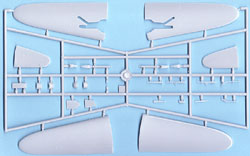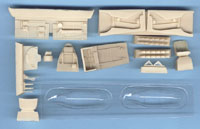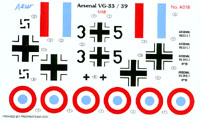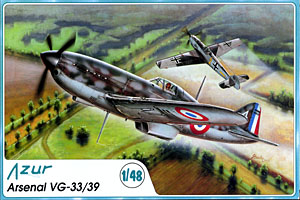Azur's 1/48 Arsenal VG-33/39 | | History The Arsenal VG-33 was an excellent fighter. It was produced in the late Ď30ís, but production was stopped by the war. Developed by the Aresenal de lí Aeronautique, the VG-33 was a light fighter built of non-strategic materials (wood). The VG-33 was powerfully armed: a 20mm cannon and four 7.5mm machineguns. The prototype first flew during the spring of 1939 showing excellent performance. It reached a top speed of 346 mph (558 kph) during official test flights in August of 1939. Before the fall of France only 160 had been built of the 200 ordered. Of these hardly ten were ready for operational service. All VG-33ís were seized or destroyed by the Germans except for ten that escaped to the south. The Arsenal VG-39 was a re-engined VG-33. The original HS 12Y-31 (860 hp) was replaced with the HS 89ter (1280 hp). The dramatic increase in power brought the top speed up to 385 mph (620 kph). Only one VG-39 was built. It was test flown just before the French surrender.  The Kit The Kit
The kit is packaged in an attractive box showing a VG-33 buzzing past a Me-109. (Perhaps this is one of the ten aircraft that were able to escape south?) The box advertises " Design and conception in France. Tooling and molding in Czech Republic." That makes me wonder if this is the same plastic thatís in the also FM 1/48 VG-33. Anyhow, the parts are molded in a familiar gray plastic. The parts all appear to be flash free. The resin detail bits are cast in the now familiar tan material. They look to be standard fare. Normal casting plugs that will need to be cleaned up but no major surgery.  The plastic parts are all cleanly molded with very fine, recessed panel lines. As I mentioned above there is no flash to clean up. The parts are very thin too. I will be surprised if the cockpit walls will require any thinning to get the resin cockpit in. I did notice one flaw the horizontal stabilizers. The left and right horizontal stabilizers are molded separately as one piece, instead of splitting them between top and bottom. As a result the plastic is a little too thick for good molding and a small sink mark is apparent. This is not a big deal. A little Squadron putty with a sanding stick and it will be a solved problem. My overall impression of the plastic is very good. The plastic parts are all cleanly molded with very fine, recessed panel lines. As I mentioned above there is no flash to clean up. The parts are very thin too. I will be surprised if the cockpit walls will require any thinning to get the resin cockpit in. I did notice one flaw the horizontal stabilizers. The left and right horizontal stabilizers are molded separately as one piece, instead of splitting them between top and bottom. As a result the plastic is a little too thick for good molding and a small sink mark is apparent. This is not a big deal. A little Squadron putty with a sanding stick and it will be a solved problem. My overall impression of the plastic is very good. Azur takes an interesting approach to including the VG-39 in the kit. Basically they included a conversion nose with the kit. The VG-33 is completely molded. If you desire to make the VG-39 you have to whack off the VG-33 nose at a panel line and glue in the VG-39 nose. The good news is there are no extra join lines to fiddle with if you decide to build the VG-33. The bad news is you are going to have to be very careful cutting the nose off if you want to build the VG-39. I like the approach since I am planning on building the VG-33.  The resin detail bits look very nice too. A complete cockpit tub is provided as well as landing gear bays, exhaust stacks for both variants and a radiator insert. My copies are bubble free. The casting plugs are intelligently positioned for easy removal. The detail on all these pieces is very high too. I give the resin high marks for quality, detail and ease of use. The resin detail bits look very nice too. A complete cockpit tub is provided as well as landing gear bays, exhaust stacks for both variants and a radiator insert. My copies are bubble free. The casting plugs are intelligently positioned for easy removal. The detail on all these pieces is very high too. I give the resin high marks for quality, detail and ease of use. Azur provides two vac canopies. Iím so happy when manufacturers make the little extra effort to do this. Invariably I will attempt to cut the first one out in order to display the canopy open. Iíll botch it. Then I decide to play it safe and cut the second one out to display closed. The parts happen to be very thin and clear too. Absent are any annoying dimples needed for the vacuforming process. The frames are lightly raised so masking should not be much of a chore. Azur gets high marks from me for their vac canopies. The instructions are generic exploded drawings consisting of five steps. The assembly process is very clear. My only beef is I wish they had included a more concise camouflage guide. They only provide one half of the camo pattern for each of the three different aircraft that can be modeled. More research will be required to paint an accurate model. Oh wait! I have two beefsÖ They color guide only refers to the colors needed by name. More research will be needed to choose the correct shade of gray, blue etc. Not a big deal, but it would be nice to have this information included. Iím satisfied with the instructions. Thereís a little room for improvement, but I think some modelers enjoy researching their subject as much as building it. Therefore my gripes are almost moot.  The decals are for three different machines: two VG-33ís and the one VG-39. The first VG-33 scheme is as the French flew it. The second is as the Germans flew it. The third is for the VG-39 in French markings. The decals look nice and are in register. Propagteam printed them so be ready for very thin, delicate decals. The decals include all the national insignia for the above mentioned aircraft, complete with swastikas for the German bird. Although you have to assemble each swastika from two decals, they are still included. There are a few stencils too. The decals look very good to me on the sheet, but Iím going to withhold final judgment until I use them. The decals are for three different machines: two VG-33ís and the one VG-39. The first VG-33 scheme is as the French flew it. The second is as the Germans flew it. The third is for the VG-39 in French markings. The decals look nice and are in register. Propagteam printed them so be ready for very thin, delicate decals. The decals include all the national insignia for the above mentioned aircraft, complete with swastikas for the German bird. Although you have to assemble each swastika from two decals, they are still included. There are a few stencils too. The decals look very good to me on the sheet, but Iím going to withhold final judgment until I use them. Conclusion I really like this kit. It looks as good as anything Eduard has produced lately (granted I havenít seen the reportedly beautiful P-400). If anything this kit reminds me of the 1/48 MPM Morko Morane. The plastic, resin and construction method look very familiar. The kit is well engineered with nice detail that promises to be fun to build. It also fills another gap in the WWII 1/48 scale collection. I also must include a warning to those who havenít built a limited run kit before. There are no locating pins and a little more work will be required than on a Tamiya kit. Still, I canít wait to get started on mine (actually I already haveÖ Itís going great!) | 









    |
